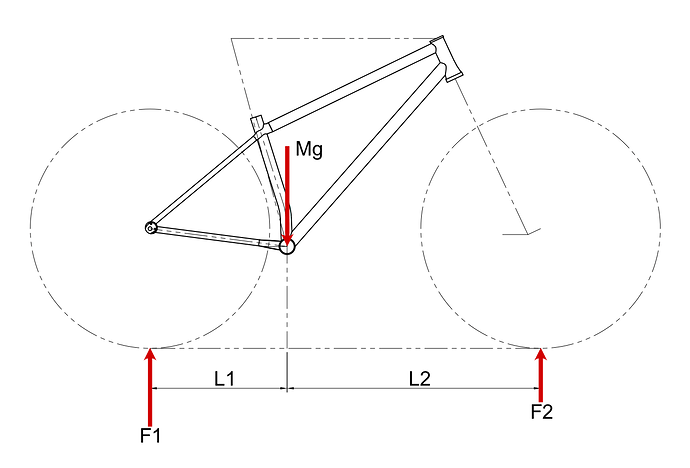Finally, a civil discussion about chainstay lengths on the internet. We have come so far!
As many people expressed, CSL cannot be talked about without front center, or a more generalizable variable: Rear Front Ratio (RFR):
From this thread: What are your driving dimensions and why? - #15 by Daniel_Y
rear-front ratio (RFR).
RFR = L2/L1
A quick derivation:
Rear wheel force: F1 = L2/(L1+L2) * Mg
Front wheel force: F2 = L1/(L1+L2) * Mg
The rear/front ratio is really easy to calculate because most of the terms cancel themselves out:
rear-front ratio: RFR = F1/F2 = L2/L1
I agree with a lot of the subjective and objective feelings that people have with chainstay length:
Agreed. I think there are some weird effects here too:
- longer chain = more chain stretch under load
- more weight on the back tire = more direct feeling with the power transfer
Rocky, techy, punchy climbs do really well with short chainstays IMO. You get more rear wheel grip and can loft the wheel easily. This is why Steve at Hardtail Party likes super short chainstays in Sedona
I think one of the funnier Poertner podcasts was about the Placebo effect. If you feel faster and go faster, it is faster!
Yup, 460mm stays are a hard sell when there is 10 years of “shortest chainstay possible” marketing to overcome! However, we are leading the charge!
Backward geometry for upduro racing!
Agreed. I think the super short chainstays makes sense with the PVD system: very long front center, super steep STA. That pulls your CG forward more than the CSL is shortened. Hardtail party Steve also sets up his very moderate Hummingbird like that:
- saddle slammed forward
- sized up a frame
- Mid-foot position
2000m of loaded climbing, no thanks! ![]()
